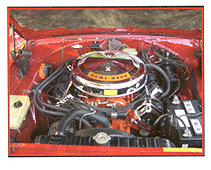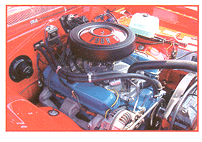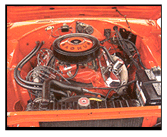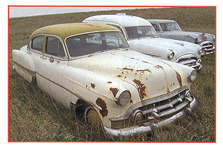There’s a hot trend in the automotive aftermarket to return car owners to the past. Literally. Today, aging baby boomers are spending big money on “recapturing the rapture” of the cars of their youth.
 Just turn on your television any evening and you’re sure to find some type of automotive program on the cable and satellite channels. Recently the Learning Channel ran a 10-part series called Rides, which focused on tricked-out dream machines and their makers. Tune into the Discovery Channel and you can catch episodes of American Hotrod and Monster Garage. Click the remote over to the Speed Channel and you can view programs such as American Muscle Car, Barrett-Jackson Car Search, which is based on the wildly successful series of classic car auctions, or My Classic Car, which focuses on muscle cars, hot rods, local cruise-ins and museums.
Just turn on your television any evening and you’re sure to find some type of automotive program on the cable and satellite channels. Recently the Learning Channel ran a 10-part series called Rides, which focused on tricked-out dream machines and their makers. Tune into the Discovery Channel and you can catch episodes of American Hotrod and Monster Garage. Click the remote over to the Speed Channel and you can view programs such as American Muscle Car, Barrett-Jackson Car Search, which is based on the wildly successful series of classic car auctions, or My Classic Car, which focuses on muscle cars, hot rods, local cruise-ins and museums.
And soon, another cable channel called WheelsTV will offer 24 hours of original automotive programming on hot rodding, muscle cars, sports cars, antiques, classics, club racing, vintage racing and restorations.
Providing restoration work could be right up your alley, especially if you already have the tools, space, technicians and the love of seeing cars of yesterday on the roads today. Whether you’re looking for an alternative to the more mainstream OE market or just looking for another area to help fill in the gaps, there are a lot of opportunities in the restoration market, according to Doc Frohmader, a vintage engine guru from Mount Olive, IL, and restoration columnist for Engine Builder magazine.
Being willing to take on new stuff and do the necessary research to restore a vehicle is a big part of the challenge. However, if you don’t have all of the engine building equipment, some of the engine work may have to be outsourced. Our advice? Use an engine builder that is reputable and can handle the work.
“Someone who is really prepared to do machine work won’t care if it’s a 1902 Cadillac or a small block Chevy,” says Frohmader. “If they’re set up properly, an engine is an engine. It shouldn’t matter what it is as long as they know what specs to build to.”
Of course, another issue to consider before jumping into the work is space. If you are going to get involved in vehicle restorations, make sure you have the area, extra building or an addition that can be tied up for a while. Painstakingly accurate vehicle restorations will take some time.
 And take extra care in price quoting these jobs. “Don’t lump-sum these specialty engines. – say that what you’ll do is itemize,” Frohmader explains. “Tell your customer what the price is up front and what you’ll do – make it clear. How you write it up is very important.”
And take extra care in price quoting these jobs. “Don’t lump-sum these specialty engines. – say that what you’ll do is itemize,” Frohmader explains. “Tell your customer what the price is up front and what you’ll do – make it clear. How you write it up is very important.”
If you work on an itemized basis and the job takes more time, then you won’t be working those extra hours for free. Therefore, it’s a good idea to keep the customer involved with the process and get them to approve additional labor or parts expenses when they do come up.
Understand too, that there are definitely some differences between doing OE work and restoration work. A lot of mainstream engine builders are satisfied with what Frohmader calls “taxi cab rebuilds,” meaning it doesn’t have to be perfect, just good enough for specs to get the thing back on the road again. In contrast, he says, “customers who are going to spend a lot of money on a restoration job want their cars to sing ‘yankee-doodle-dandy.’ Consequently, the mark-up is higher for these more demanding restoration jobs because the customers are willing to pay to have everything restored ‘just right.'”
Muscling In
So how do you break into this business? A good way to find customers is to join local vintage-car clubs. If your shop services a lot of GM vehicles, maybe the way to go is to talk to the Buick club, for example. There you’ll find guys who are looking for your services. Remember, get involved with these groups and your reputation will get you business by word of mouth,” he says.
“A lot of car clubs have websites that allow you to advertise your services for a nominal fee – that’s one way. Another way to get the word out is through niche publications,” Frohmader explains. Car clubs and vintage magazines offer another avenue to promote your services. Many car collectors turn to Hemmings Motor News, which is like the industry Bible, not only to advertise in but also to find parts and do research as well. Also, letting parts suppliers know that you work on vintage engines will help bring in work too, says Frohmader.
It’s also a good idea to get familiar with the restoration industry’s parts suppliers. Get their catalogs and talk to their reps. They can be invaluable fountains of knowledge for hard-to-find parts and information. Search engines on the web have dramatically improved parts hunting. And just because a part is not listed or available doesn’t mean that there isn’t an alternative solution. “A lot of times you can use size charts, for instance, for piston selection,” says Frohmader. This is where the creativity part comes in. “You can’t be totally stuck on putting things back the way they were in, let’s say, 1956. There has been quite a jump in automotive technology since then.”
 Salesmanship is another ingredient to getting and keeping restoration work. Having a professional looking organization makes a big difference. How you present your business to a customer is going to leave a lasting impression. A big pile of engines and parts in a corner isn’t going to give the customer a lot of confidence in your ability. Even if you’re the best shop around – if you don’t look the part, people are going to go elsewhere.
Salesmanship is another ingredient to getting and keeping restoration work. Having a professional looking organization makes a big difference. How you present your business to a customer is going to leave a lasting impression. A big pile of engines and parts in a corner isn’t going to give the customer a lot of confidence in your ability. Even if you’re the best shop around – if you don’t look the part, people are going to go elsewhere.
Muscle Cars Nearly Headed for Extinction
Two years ago, car hobbyists and related businesses scored a major victory when the U.S. Senate voted to approve an amendment to remove old car scrappage language from the “Energy Policy Act of 2002.”
 According to SEMA, the vehicle scrappage provision (Section 822 of S. 517) would have created a new U.S. Department of Energy bureaucracy to federally fund state-run scrappage programs for vehicles over 15 years old. Under the program, owners who turned in vehicles for crushing would have received a cash payment and a credit toward purchasing a newer vehicle, in an ostensible attempt to improve the overall fuel economy of the country’s vehicle fleet. The scrappage provision would have denied automotive aftermarket businesses the availability of older cars necessary to market products and services. It also threatened vehicle enthusiasts nationwide with the loss of valuable parts and parts-cars for repair, restoration and customization projects.
According to SEMA, the vehicle scrappage provision (Section 822 of S. 517) would have created a new U.S. Department of Energy bureaucracy to federally fund state-run scrappage programs for vehicles over 15 years old. Under the program, owners who turned in vehicles for crushing would have received a cash payment and a credit toward purchasing a newer vehicle, in an ostensible attempt to improve the overall fuel economy of the country’s vehicle fleet. The scrappage provision would have denied automotive aftermarket businesses the availability of older cars necessary to market products and services. It also threatened vehicle enthusiasts nationwide with the loss of valuable parts and parts-cars for repair, restoration and customization projects.
In a related issue, a California Air Resources Board (CARB) e-mail notification program provides consumers, collectors and restorers the opportunity to buy scrapped vehicles or parts from those vehicles before they are destroyed.
The e-mail program not only notifies interested parties of a vehicle’s potential scrappage free of charge, it also provides a substantial waiting period before its destruction. So, if a person requests to see a scrapped vehicle, the period until the vehicle’s destruction can be extended as much as one week. Previously, cars and trucks could be destroyed as soon as they were inspected and the necessary paperwork was processed, precluding any vehicle rescue or parts sales.
If you are interested in subscribing to this e-mail program, go to www.arb.ca.gov/msprog/avrp/emailnotification.htm.
Yes, there are many things to consider before jumping into the restoration market. But the opportunities are there for the right shop willing to try something different. You can be successful if you’re willing to be creative and willing to charge a good rate for the services you provide.
You don’t have to jump in all at once, either. If you’re looking just to fill in gaps in your work schedule, try smaller jobs at first just to get your feet wet. Join a local car club and talk to their members – they’ll surely tell you what they need – and maybe will pass you some of their restoration work!
Does your shop perform restorations, custom jobs or muscle car renovations? If so, we’d love to hear from you. Drop us a line on what you do, tips you recommend or photos at [email protected]. Your responses will help us gear future underhood restoration articles toward your needs.
|
The Market Defined
According to SEMA, the restoration market is generally comprised of four groups: antiques manufactured before 1920; domestic vehicles manufactured from 1920 to World War II (also classified as antiques); post-World War II domestic vehicles built through the 1950s, ’60s and ’70s (referred to as classics); and foreign vehicles. A true restoration will return a vehicle as close to brand new as possible. Engine restoration experts recognize two types of restoration – show and street. The main difference between the two is that show vehicle restoration (sometimes called “100-point”) brings the vehicle as close to perfection as possible with a total disregard for cost. These restored vehicles are seldom, if ever, driven on the street and obviously will bring shops the highest levels of profit. Street restorations on the other hand, are usually done for customers who expect to drive their vehicles infrequently for pleasure. Performance modifications are very common to increase durability, and the level of detail is usually less than that of a show restoration. Fred Seidel of Fred’s Engine Service is a one-man restoration operation in Rochester, NY. His shop is nestled on the same property as his home. That suits him just fine because it’s about a 200-foot commute to work every day. But he says that working from his home in this business doesn’t allow for much free time – he hasn’t had a vacation in 10 years, he claims. Seidel said he made a conscious decision a number of years ago to get into restorations exclusively. “Anything to do with the collector car market is strong right now – it’s not a segment filled with people who don’t have a lot of money. It’s definitely not a poor man’s hobby.” Seidel explained that customers don’t view car collecting as an investment, rather those who are into collector cars are in it for the love, not the money. “The people who are into collector cars know they are going to spend thousands of dollars and probably put in more money than what they’ll get out.” “Many times the collector has a sentimental connection to the automobile that is being restored, and money is not really an issue. Bringing the past back to life is what’s most important to them.” Seidel said he had an advantage in the beginning because many of the projects he restored were what he used to work on in his youth. He still remembers how to rebuild parts that today are simply just replaced, i.e., alternators and starters, etc. “I’ve found that in order to do engines, you have to take the whole car,” Seidel explains. “It’s a high-risk market that isn’t for the weak-at-heart.” If you are getting involved in this work, be prepared for long turnaround times. Typically, they are from six to 12 months, and most of this can be blamed on searching for and waiting on parts. For example, Seidel explained he had a ’26 Continental fire engine in his shop with a bad engine block. Seidel said the vehicle owner located a new block, but had to negotiate to buy it, which took more than two months. According to him, these types of scenarios are common in the restoration market. |
|
Restoration Pro Tips:
Say Cheese! One thing to do when working on restoration projects is to take plenty of pictures. “We take about 10-15 pictures of each car/engine (all different angles). And on top of that, we make pretty detailed drawings too,” said Jay Steel, owner of Taylor Engines in Whittier, CA, a shop that specializes in pre-1940 vehicles. “You have to get pretty creative sometimes because a lot of times there isn’t much reference material available.” Steel recommends making drawings of things such as the firing order before you take it all apart and forget which way things go. If you’re thinking that all this detailed work like photos, drawings and making fasteners sounds pretty time consuming – it is. And Steel said he charges appropriately for it too. Here are a few more tips from the pros:
|
Trademark Ford
In March, an agreement was reached concerning licensing arrangements for use of Ford trademarks on licensed reproduction products. The agreement is the result of lengthy discussions between Ford Motor Company and members of the Automotive Restoration Market Organization (ARMO), the SEMA council representing the automotive-restoration segment. According to SEMA, Ford and ARMO members have been engaged in negotiations regarding the use of Ford trademarks and part numbers on reproduction parts for vintage Ford products, and the cost to use the trademarks. SEMA reported that the discussions about the licensing agreement involved a number of breakthroughs. First, Ford has agreed to provide a three-year contract to its licensees rather than the initially proposed one-year term. Second, all licensees will be given the same terms of agreement, without variation. Third, licensees will pay a 7% royalty fee on the use of Ford trademarks and a fee of $1 per part that bears a Ford trademark or Ford part number, up to a maximum of $1,000. Fourth, only one licensee in the distribution chain will have to pay the fee. If a manufacturer reproduces a part that is then sold by a retailer, only the manufacturer pays a licensing fee – the retailer will not have to pay. Finally, no reporting requirement or fee is required if a Ford trademark is used only in an informational capacity, for example, in a catalog to describe a part application. “We all acknowledge that Ford is entitled to protect its trademarks and other intellectual property, which are extremely valuable assets,” said Steve McDonald, SEMA senior director of government affairs. “The Ford brand has been a major contributor to the nearly 100-year heritage of classic automobiles. However, Ford could not trade on this heritage without dedicated reproduction-parts makers and retailers. Their passion is to maintain and foster the Ford name by providing the same parts for these classic cars that we see at shows and on beautifully restored vehicles on the road. Common sense and reflection on both sides have carried the day, and we are pleased that (SEMA Chairman Corky) Coker was able to convey to Ford the concerns voiced by its reproduction-parts licensees.” |
